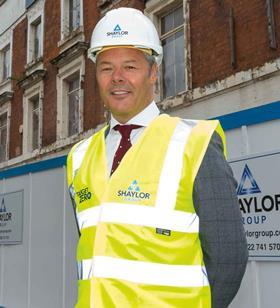Shaylor Group collapsed in June, owing at least £18m and making 200 people redundant. Jonathan Owen reports on how the firm became one of an increasing number of companies to crash into insolvency

Just one year ago, Shaylor Group was riding high. Stephen Shaylor, chief executive of the company founded by his father Fred in 1968, stood shoulder to shoulder with Prince Harry to announce the start of construction on a museum at the Silverstone race track in Northamptonshire.
The Midlands-based group was also working on jobs ranging from a major refurb of the music venue Wolverhampton Civic Hall, to a residential development in east London, and building a Doubletree by Hilton hotel in Birmingham.
Yet in little more than 12 months, the family firm’s reputation has been ruined, perhaps irreparably, in a dramatic fall from grace.
Shaylor Group’s sudden collapse last month, with more than 200 staff losing their jobs overnight, was the latest in a lengthening line of construction companies going under.
But the manner in which staff were told, amid allegations of greed by directors, has prompted fury among staff and subcontractors, who are owed at least £18.8m.
So, where did it all go wrong for the Shaylor Group? And should this be a cautionary tale for SMEs in the construction industry?
�ǿմ�ý has spoken to a number of former employees and subcontractors, some of whom are close to the company’s board of directors.
The warning signs were visible in 2012, when Shaylor Construction went into administration and left a number of subcontractors out of pocket, including Tim Bartlett.
His firm, TJB Metal Design, was owed £50,000. “I should have said ‘No, I’m not doing any more, I’m pulling the guys off site until I’m paid’,” he said. “My advice to others is to stand your ground, and if you feel something’s iffy, don’t do any further work because at least that’s damage limitation.”
In 2013 Fred Shaylor died, and his two sons Stephen and Richie continued to run the company, later joined as directors by their sister Lana.
Turnover more than tripled between 2013 – when it stood at £43.5m – and 2018, when it was £141.8m. And the number of staff rose from 132 to 244 in this time, as the firm took on larger jobs and secured places on major government frameworks.
“They were paying accelerated costs and phenomenal amounts of money just to keep big jobs going”
Rich Pugh, former QS at Shaylor Group

Too much, too soon?
But some claim the pace of change was too great. A former employee, speaking under condition of anonymity, said: “The Shaylors expanded too aggressively and bit off more than they could chew, and went into areas they weren’t experts in. They stepped away from their bread and butter, which was big refurb jobs.”
The Shaylor Group’s most recent accounts, to last September, present a positive picture, with turnover at £141.8m – only slightly down from £143.8m in 2017 – and pre-tax profit up at £7.6m. However, there was a sharp drop in cash in hand and at the bank from £14.7m to £8.6m from 2017 to 2018.
The group’s six executive directors split £1.3m between them, with the highest-paid director being paid £340,000 – up from £259,000 the year before. The accounts show that £8.7m had been paid out in dividends in 2017.
“Everyone that wasn’t a Shaylor was kept in the dark. the father made the business, the sons destroyed it”
Former manager, Shaylor Group
In October 2018, the Shaylor Group changed from being a Plc to a limited company and a new company was created, Shaylor Group EOT Limited, which involved a loan from Allied Irish Bank.
Shaylor Management Services Limited, a subsidiary of the Shaylor Group, owes Allied Irish Bank £14.5m.
�ǿմ�ý contacted Shaylor for comment but to date no response has been forthcoming.
Cracks started to show late last year, when subcontractors were being paid later and later. And in some cases not at all.
Rich Pugh, who was a project quantity surveyor at the firm, told �ǿմ�ý: “We weren’t paying subcontractors from late last year and there was an awful lot of money taken out of the business and that’s what caused the damage.”
The firm wanted to have big jobs to make the order book look good and attract potential buyers, he said. “They were paying accelerated costs and phenomenal amounts of money just to keep big jobs going.”
The company had been hit by “massive penalties” on projects that overran, he added. On one job alone, a student accommodation project in Reading, it was hit with liquidated damages of around £80,000 a week, Pugh claimed.
‘It forced me to wind up the company I ran’
Tim Bartlett, managing director, TJB Metal Design, was forced to wind up his previous company after Shaylor Construction went under in 2012, leaving him tens of thousands of pounds out of pocket.
“I was a domestic subcontractor to them for quite a few years, specialising in architectural metal work. We worked on job at King Edward’s school in Birmingham, a 50-grand job. Then when it was time for the payment to be made there was nothing in the bank, which was very unusual, they had always been very good payers,” he said.
“When we followed it up, we found out that they had basically liquidated the company. I was one of many subcontractors who lost a hell of a lot of money in 2012, and never got it back.
“I ended up paying some of my suppliers with my own money and it forced me to wind up the company I ran at that time. The whole thing left a very nasty taste in my mouth. It was completely out of the blue, no warnings, nothing at all. I’m surprised that they’ve lasted this long, I’d have thought they would have gone a bit earlier.”
In April, directors brought in restructuring specialist FRP Advisory to review cash flow. Just weeks later it was also tasked with reviewing contingency options. The firm has since been appointed as the company’s administrators.
Things finally came to a head three weeks ago, when staff were sent home from work on Friday 14 June and told to expect an announcement the following week. Instead, they were informed of the firm’s collapse, and the loss of their jobs, via email on Father’s Day, Sunday 16 June – three days before they were due to be paid.
The email, sent by PA Sharon Goodwin on behalf of the board of directors, blamed project delays, payment disputes, and the failure of key subcontractors for a “severe impact on the group’s cash flow”.
Anger at the group’s collapse was exacerbated after it emerged that Shaylor employees at university had not had their fees paid.
These trainees are among more than 200 people, some of whom have spent their entire working lives working for the family-run business, facing an uncertain future.
The firm’s former employees are owed at least £1.8m in redundancy, pay, and pension contributions.
‘Payments started getting really slow’
Fabian Daroczy, director, R&D Demolition UK, is one of a number of subcontractors left out of pocket by the collapse of the Shaylor Group.
“A lot of subcontractors had not been paid, including me. Everyone’s payments, from January, started getting really slow. Instead of 60-day payment terms, you end up getting into hundreds of days, then you were never getting paid what you were supposed to get paid.
“They owe me more than £100,000 but that’s nothing compared to M&E guys who are in for about £800,000; sparkies for £600,000; and steel fixers for £200,000 – and that’s just from one project.
“This was a badly managed company. Their build side lost money hand-over-fist down to poor management because they just didn’t know how to manage it. It was them not being able to manage their growth, not having the right people, and not enough experience on the build side.”

Subcontractors burned
Subcontractors have also been hit hard, with a number said to have already gone out of business as a result of the company’s collapse.
�ǿմ�ý understands that at least £17m is owed to subcontractors – a figure that could rise to around £26m.
One long-standing subcontractor said: “Over the last 12 months it’s been very difficult to get money out of them. I took them on their word that we’d get paid, we’ve all believed the lies. They owe us a six-figure sum. Fortunately we have a pot in our retained profit but that’s 10 years’ hard work which should have been there for our retirement just blown out of the window.”
According to a former employee, while the firm’s late founder Fred was “always straight with people”, his sons “have basically trashed the reputation of the company”.
The company’s collapse had “nothing to do with the market, it was the crap jobs we were taking at low margins”, the source added.
Richie Brown, who worked as an assistant site manager for the firm between 2011 and 2016, insisted the Shaylors were “good people” and said: “They would not have wanted this to happen but things go wrong in business.”
However, one former manager said: “Fred would be turning in his grave, he really would.
I think it was blind greed and mismanagement that caused this […] everyone that wasn’t a Shaylor was kept in the dark. The father made the business, the sons destroyed it.”
Whatever the true reasons for the demise of the Shaylor Group, it seems to be part of a wider problem. Construction had more firms falling into insolvency than any other sector last year, with almost 3,000 going under – the highest number in six years, according to the latest government data.
The company’s collapse is indicative of an industry where wafer-thin margins leave little or no room for manoeuvre if – and when – projects fall into difficulties. “It is not a sign of a healthy market,” according to Martin Hewes of consultant Hewes Associates.
And when firms go under, the jobs they were doing for clients are disrupted.
Take the Silverstone project. The collapse of the Shaylor Group means the opening of the new museum has been delayed until September at the earliest, meaning it will not be visited by hundreds of thousands of fans due to descend next weekend.
And it’s unlikely that Stephen Shaylor and Prince Harry will be sharing a platform again any time soon.























No comments yet